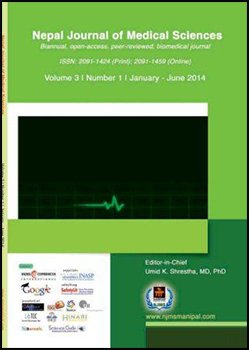Family Planning and Health Commodities Security in Nepal
DOI:
https://doi.org/10.3126/njms.v3i1.10359Keywords:
Commodities security, pipeline, quantification and forecasting, stock-outsAbstract
Background: Commodity security is essential for effective delivery of quality health services. Commodity security exists when people are able to choose, obtain and use products whenever they need them. With leadership of Government of Nepal’s Logistics Management Division and with technical assistance from United States Aid for International Development funded projects have been consistently working toward this goal with priority to Family Planning (FP), Reproductive Health, and Maternal Child Health commodities.
Methods: A National Consensus Contraceptive Security Forecast meeting is held annually at center. The meeting is participated by Regional, District, Program Divisions, National Planning Commission, Ministry of Finance, External Donor Partners, Social Marketing agencies, and Non Governmental Organizations (NGO). The quantity needed, shipment schedule, funding requirement and funding shortfall, distribution and storage strategies for the Public, Social Marketing, and NGO sectors are presented for next five years.
Results: With secured funding, increased availability of family planning commodities (stock-outs rate is less than 2%) at service delivery sites have contributed to improve national health indicators like Total Fertility Rate and Contraceptive Prevalence Rate. Key program interventions have ensured FP commodity security through effective coordination of public, private and external donor partners.
Conclusion: Key lessons learned was a spirit of ‘Teamwork’ and good coordination –active involvement of other stakeholders is essential for ensuring FP commodity security. Other was an importance of ‘Advocacy’ for commodity security at district, regional and central levels of government and among stakeholders. Challenges are complexity of public procurement procedure and frequent transfer of trained staff, and distribution and transportation of health commodities from district to health facilities still poses a challenge to supply chain management.
Nepal Journal of Medical Sciences | Volume 03 | Number 01 | January-June 2014 | Page 51-56
Downloads
Downloads
Published
How to Cite
Issue
Section
License
Copyright © by Nepal Journal of Medical Sciences. The ideas and opinions expressed by authors of articles summarized, quoted, or published in full text in this Journal represents only opinions of authors and do not necessarily reflect the official policy of Nepal Journal of Medical Sciences or the institute with which the author(s) is (are) affiliated, unless so specified.




